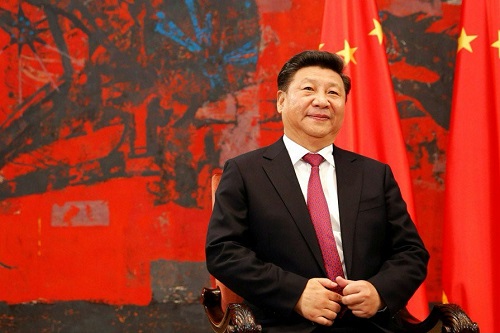Reuters photo
By
Tom Arms
Some call it the Chinese Marshall Plan. Others call it a dastardly plot for world domination and confirmation of the darkest fears of the “Yellow Peril.”
The Chinese – with their easy facility for metaphorical phraseology—call it the “Belt, Road Initiative.” The term is a reference to the old Silk Road which stretched from East to West and dominated trade between the Orient and Occident from before Rome up until the 16th century when the Portuguese and Spanish discovered sea routes to America and the Far East. Those were the days when China was the fabled world economic power house with whom everyone wanted to trade.
It was the land where an ancient civilisation had invented and developed essentials such as paper, compasses, silk, porcelain, gunpowder, moveable type, mechanical clocks, tea, iron smelting, bronze, rockets, the seed drill, and even pasta and the toothbrush. There were no economists around to keep GDP records, but bean counting historians believe that in the early 16th century China produced 40 percent of the world’s wealth. This is roughly equivalent to that of Britain at the height of its empire or the US in the 20 years after the Second World War.
The Chinese see no reason why that trade—and their position in the world—cannot be revived by emulating the example of the silk road with an omnidirectional series of trade links and infrastructure projects using land and sea routes. The term ‘belt’ in fact, refers to the land routes, either by rail or road. The term ‘road’ refers to sea routes. The project involves building political links in 71 countries, infrastructure projects to move goods and massive injections of aid and loans to primarily African countries to insure access to essential raw materials. The estimated cost is $1 trillion.
Critics say that trade routes need to be secured by military means which leads to military dominance. As proof of the danger, they cite the example of Beijing’s military build-up in the South China Sea. They also worry about China using its massive domestic market of 1.4 billion consumers to produce cheap goods that can be dumped on Western markets. Another concern is that easy Chinese loans are creating a debt trap which is damaging the world economy and, finally, its no-questions-asked aid and investment in authoritarian Asian and African countries is undermining the rule of law and governance in developing countries.
Supporters ask: Why can’t the Chinese pursue their national interests through the pursuit of peaceful trade? And, can we stop them short of a disastrous military conflict? The 16th century was the Spanish century. The 17th century belonged to the French. The 18th and 19th centuries were dominated by the British Empire and the 20th has become known as the American century. Most people believe that our own 21st 100 year period since the birth of Christ will be the Chinese century and nothing can be done to prevent it. Finally, the supporters of the Belt, Road Initiative point out that roads and sea routes run two ways and the internet goes all over the place.
The main target of the Belt, Road Initiative is the European Union with its 512.6 million people producing the world’s largest GDP ($19.7 trillion). The bulk of its investment is going into infrastructure projects in central Asia and Eastern Europe which will link the two ends of the Eurasian land mass. It has bought a 51 percent stake in the Athens port at Piraeus, invested heavily in infrastructure projects in Turkey, Pakistan, Kazakhstan, Armenia, Azerbaijan, Russia, Turkmenistan, Kyrygzstan, Uzbekistan and the United Arab Emirates. The UK has broken ranks with the US and EU to join China’s Asian Infrastructure Investment Bank. Eastern European members of the EU have signed political and economic agreements and meet regularly with the Chinese leadership.
Africa is the next target. China needs its untapped resources to feed and fuel its manufacturing base and sees the dark continent as the next big emerging market. President Xi Jinping recently announced another $60 billion aid tranche for Sub-Saharan countries, dwarfing the cash from America and Europe. Much of the aid is in the form of soft loans. But they are not soft enough for developing countries who, it is feared, are falling into a Chinese owned and administered debt trap. Beijing already holds 90 percent of Djibouti’s foreign debt and 80 percent of Pakistan’s. Nineteen percent of America’s foreign debt is held by China. But then some economists quote the old adage: When you owe the bank $100 the bank owns you. When you owe the bank $100 million you own the bank.
Tom Arms
I am a journalist, entrepreneur and historian with extensive experience in print, web and broadcast journalism. I started as a diplomatic correspondent, wrote several books (The Falklands Crisis, World Elections On File and the Encyclopedia of the Cold War), and then in 1987 started my own business (Future Events News Service, www.fensinformation.com) which over 25 years established itself as the world and UK media’s diary. Our strapline was: “We set the world’s news agenda.” I sold FENS in December 2012 but retained the exclusive broadcast rights to all of FENS data. To exploit these rights I set up LookAhead TV which produces unique programmes which “Broadcasts Tomorrow Today” so that viewers can “Plan to Participate.” LookAhead has appeared regularly on Vox Africa, Radio Tatras International, The Conversation and Voice of Africa Radio.
In addition to being a syndicated broadcaster and columnist on global affairs, Tom is also available for speaking engagements and can be contacted on Twitter, Linkedin and email: [email protected].



No Comments Yet!
You can be first to comment this post!